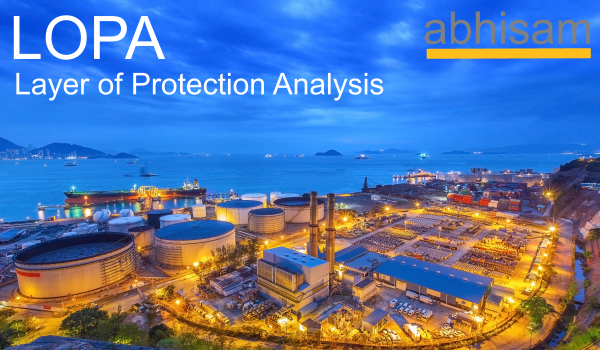What is LOPA?
LOPA stands for the Layer of Protection Analysis technique. It is also referred to by some as Layers of Protection Analysis. Both refer to the same thing.
LOPA can be considered to be a semi-quantitative risk assessment technique used to not only assess the risk in an industrial process, but also helps design and mitigate it so that the residual risk of the process is within the tolerable risk.
What is Risk?
Risk is the likelihood that a hazard (which is a potential source of harm) actually results in an accident or other unwanted event. Hence Risk is often shown in the form of the following equation
Risk= Frequency of Occurrence X Consequences
Thus we can reduce risk either by reducing the frequency of occurrence or by reducing the consequences if something occurs. Thus if we consider an oil storage tank as a hazard, then the risk could be the number of times it overflows multiplied by the damage that this can cause if the spilled oil catches fire.
What is Tolerable Risk?
All installations like the example of the oil storage tank shown above, have some risk of fire or explosion, or other unwanted event. The risk can be low but never zero. This non zero number, which is acceptable to the tank or site owner or operator is known as the tolerable risk.
You may have several protections as part of the design, but every protection has some failure rate, however low and thus there is a chance of failing sometime. As long as the risk is below the tolerable risk, we accept it.
How does LOPA reduce the risk?
In the tank example above, there are several protections that are built in. These may be a level indicator on the tank that an operator checks, a high level alarm, or an overfill prevention system that cuts of the inlet flow by shutting off automated inlet valves, to prevent overfilling and spillage. Additionally there might be other protections such as a dike or bund around the tank to contain the oil and/or divert it to another tank.
All these are known as protection layers. Every one of them contributes in reducing the risk by a certain extent. The detailed method that is used to do this is known as the LOPA method.
Do I always require a Safety Instrumented System to make use of LOPA technique?
Not necessarily. You can use LOPA even without having a Safety Instrumented System (SIS). The SIS is just one of the many protection layers that are used to reduce the risk in a process plant. Other protection layers may be the plant BPCS (Basic Process Control System), or stand alone controllers, or passive layers such as a dike, or active mechanical layers such as safety relief valves. It all depends on the amount of risk reduction that you intend to achieve. For large risk reductions, it is always preferable to use Safety Instrumented Functions.
Note: We have separate courses on Safety Instrumented Systems here and Functional Safety here.
What is covered in the LOPA Training course?
The Abhisam LOPA Training course covers in detail everything that you need to know in order to conduct your own LOPA study. The examples are taken from real world situations, with sample formats. The course is very detailed and we daresay there is no other course out there that offers you so much at this price.
Table of Contents of the Abhisam LOPA Course
The course consists of 12 modules, followed by a Self-Assessment Test and a Certification exam.
Here is the List of Modules
- Hazards, Risks & Risk Assessment.
- Basics of Layer of Protection Analysis (LOPA).
- LOPA methodology.
- Process Hazard Analysis (PHA)
- Estimating Consequences and Severity.
- Identifying and developing a scenario.
- Identifying the initiating Event and determining the frequency.
- Identifying independent Protection Layers (IPLs)
- Estimating the Risk of the Scenario.
- Evaluating the risk for decisions.
- Risk Reduction Measures
- LOPA Closing Session & LOPA Report
- Self-Assessment Test
How long is the course? Will I earn PDH?
The course is 60 hours long, but you can do it at your own pace as everything is available to you 24/7. You earn 60 Professional Development Hours after you complete all modules and the exam.
What is this course? Is it a video?
No it is not a video of a guy speaking. The course is a self-paced e-learning course that consists of different modules consisting of audio, text, video, animations, simulations, worksheets and assessment to give you a fantastic learning experience.
Do I get a Certificate?
Yes, of course! You take the included exam and on passing you will earn a Certificate of Competency in LOPA and also an electronic badge of a LOPA Professional, that you can display on LinkedIn and other places online. This gives you visibility in the professional community.
How do I enroll?
Simply click the Buy Now button that will open in a new window. You can use various options such as Credit Card or Paypal to buy the course. You get instant access to the course upon purchase and can start accessing the course within minutes.

